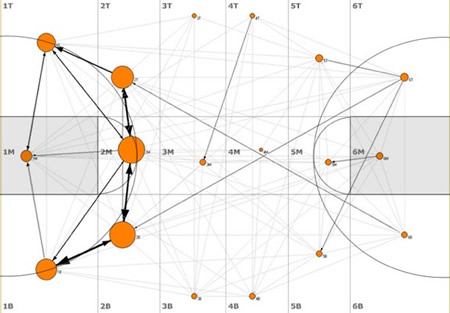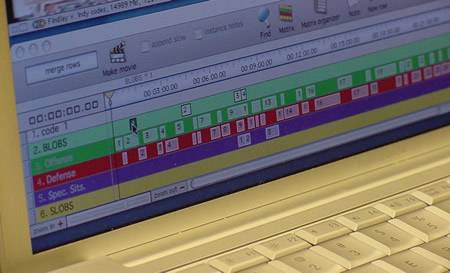I’ve refined my earlier work () to correct for some of the initial mistakes. First, I had to throw out all of the processed player data because I negected to consider in the database queries the fact that a player’s jersey number isn’t unique for all teams and games. I also adjusted the visuals to make the display a bit more meaningful, and I incorporated some conversation with Vera Jones as she prep’s for the upcoming women’s basketball season at IU. All that went into a work-in-progress presentation last night to the Networking group at Informatics.
The short summary of my talk is this: I am encouraged by the limited analysis thus far showing a visual difference between successful and failed possession chunks. A chunk is my definition for the part of a larger game possession bookended by either dead-ball activity or action. Chunks usually start with an in-bounds pass, but can also begin off of a rebound, a turnover or tip-offs. Chunks usually end with a shot — after all, that’s the goal of a play (preferably one ending in points) — but can conclude with a turnover, foul, ball lost out of bounds, the game clock, or official intervention.
Successful Possession Chunks by IU (v. Bowling Green)

Failed Possession Chunks by IU (v. Bowling Green)

The feedback from the group touched on some known issues and revealed some other concerns. Clearly, this is incomplete analysis based on exactly two games. (The “best win” being an OT victory at Purdue, and the “worst loss” being a home loss to Bowling Green.) With all of the factors that go into planning for and playing a game of basketball, there are too many variables at work to be able to draw any conclusions. However, the variety of the sampling is enough, I feel, to say there is something to the order of a succesfull play and the disorder of an unsuccessful one. That is something I would expect to remain even as more data is collected and networks are studied.
There was some question raised whether this is a network at all. It is true that it is always going to be a small network, limited by the number of players who can touch a ball, the amount of time to take a shot, and the geographical contraints of the court. That doesn’t bother me, but it definitely will need to be explained through the analysis and inevitable math that goes with network analysis. I found that particular criticism odd since by any definition, there is a definite network emerging over the course of the game. I interpreted those comments in a constructive way, to underscore the difference between a ball movement network and the less constrained and infinitely larger networks we study in class (Internet, air traffic, citations). There are just as many points of data available, theoretically, in the sum of all basketball games, but they are going to have to be conceived in a more abstract fashion to be able to potentially use those same means of analysis.
It was also suggested that concentrating on just the ball movement ignores all of the other key elements of the system — the players moving without the ball. There are two distinct reactions to that. The first is the one I started with, that what matters most in the game of basketball is where the ball is. All reactions are tied to that information. Ball movement might also be viewed as the sum effect of all of those other factors, and thus is the most important network to consider.
The other reaction is to explore the depth of these many concurrent networks of 10 players along with the movement of the ball. Mariangeles Serrano suggested that this is a flow network, where the ball is the object passing through and disturbing the network. How to connect those concurrent networks, though, is a problem. Maybe the court location, proximity to opponents, or line of sight might become the edges. It is something worth considering, although data collection for that is exponentially more difficult.
Annotating a Digital Video of a Game

Getting information off of video is not a new problem for the HCI community, and there has been some research dedicated to this issue. In fact, Dennis Groth has a tool that might be useful in automating the video analysis a bit by allowing the image itself to be annotated, not just marked for later viewing. In the short-term, I am looking at SportsTec‘s GameBreaker software (annotating video) and in-game play efficiency tracking by Fast Model that the team is planning to use for the first time this season. While no one is tracking the data I am interested in — the movement of the ball and specific players across the court — the data that is being gathered through these tools may prove to be useful. The tools themselves may also speed up the process and allow me to generate more data.
On the horizon for this project … I need to find a way to examine not just composite plays but the impact of a particular ball movement sequence or individual player on the outcome of the game. We’ll take a look at combinations of nodes to see if that analysis produces anything interesting. For this to be useful to coaches, ultimately there will need to be some quantification of that impact, some clear visual cues, and a baseline to be able to tell the unusual from the abnormal. After some consideration, I also really like Sandro‘s idea to mine similar data from computer basketball games, where the data we want to study can be extremely precise and plentiful. That adds an element of programmed behavior constrained by the code, but it completely gets around the HCI problem of data mining a real game. That may be a way to model network behavior to then apply to the real game for comparison.